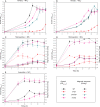The periplasmic nitrate reductase nap is required for anaerobic growth and involved in redox control of magnetite biomineralization in Magnetospirillum gryphiswaldense
- PMID: 22730130
- PMCID: PMC3430331
- DOI: 10.1128/JB.00903-12
The periplasmic nitrate reductase nap is required for anaerobic growth and involved in redox control of magnetite biomineralization in Magnetospirillum gryphiswaldense
Abstract
The magnetosomes of many magnetotactic bacteria consist of membrane-enveloped magnetite crystals, whose synthesis is favored by a low redox potential. However, the cellular redox processes governing the biomineralization of the mixed-valence iron oxide have remained unknown. Here, we show that in the alphaproteobacterium Magnetospirillum gryphiswaldense, magnetite biomineralization is linked to dissimilatory nitrate reduction. A complete denitrification pathway, including gene functions for nitrate (nap), nitrite (nir), nitric oxide (nor), and nitrous oxide reduction (nos), was identified. Transcriptional gusA fusions as reporters revealed that except for nap, the highest expression of the denitrification genes coincided with conditions permitting maximum magnetite synthesis. Whereas microaerobic denitrification overlapped with oxygen respiration, nitrate was the only electron acceptor supporting growth in the entire absence of oxygen, and only the deletion of nap genes, encoding a periplasmic nitrate reductase, and not deletion of nor or nos genes, abolished anaerobic growth and also delayed aerobic growth in both nitrate and ammonium media. While loss of nosZ or norCB had no or relatively weak effects on magnetosome synthesis, deletion of nap severely impaired magnetite biomineralization and resulted in fewer, smaller, and irregular crystals during denitrification and also microaerobic respiration, probably by disturbing the proper redox balance required for magnetite synthesis. In contrast to the case for the wild type, biomineralization in Δnap cells was independent of the oxidation state of carbon substrates. Altogether, our data demonstrate that in addition to its essential role in anaerobic respiration, the periplasmic nitrate reductase Nap has a further key function by participating in redox reactions required for magnetite biomineralization.
Figures





Similar articles
-
The oxygen sensor MgFnr controls magnetite biomineralization by regulation of denitrification in Magnetospirillum gryphiswaldense.BMC Microbiol. 2014 Jun 10;14:153. doi: 10.1186/1471-2180-14-153. BMC Microbiol. 2014. PMID: 24915802 Free PMC article.
-
Cytochrome cd1 nitrite reductase NirS is involved in anaerobic magnetite biomineralization in Magnetospirillum gryphiswaldense and requires NirN for proper d1 heme assembly.J Bacteriol. 2013 Sep;195(18):4297-309. doi: 10.1128/JB.00686-13. Epub 2013 Jul 26. J Bacteriol. 2013. PMID: 23893106 Free PMC article.
-
The terminal oxidase cbb3 functions in redox control of magnetite biomineralization in Magnetospirillum gryphiswaldense.J Bacteriol. 2014 Jul;196(14):2552-62. doi: 10.1128/JB.01652-14. Epub 2014 May 2. J Bacteriol. 2014. PMID: 24794567 Free PMC article.
-
Electron transport chains and bioenergetics of respiratory nitrogen metabolism in Wolinella succinogenes and other Epsilonproteobacteria.Biochim Biophys Acta. 2009 Jun;1787(6):646-56. doi: 10.1016/j.bbabio.2008.12.010. Epub 2009 Jan 6. Biochim Biophys Acta. 2009. PMID: 19171117 Review.
-
Metabolic regulation including anaerobic metabolism in Paracoccus denitrificans.J Bioenerg Biomembr. 1991 Apr;23(2):163-85. doi: 10.1007/BF00762216. J Bioenerg Biomembr. 1991. PMID: 2050653 Review.
Cited by
-
The transcriptomic landscape of Magnetospirillum gryphiswaldense during magnetosome biomineralization.BMC Genomics. 2022 Oct 10;23(1):699. doi: 10.1186/s12864-022-08913-x. BMC Genomics. 2022. PMID: 36217140 Free PMC article.
-
Transposon mutagenesis identified chromosomal and plasmid genes essential for adaptation of the marine bacterium Dinoroseobacter shibae to anaerobic conditions.J Bacteriol. 2013 Oct;195(20):4769-77. doi: 10.1128/JB.00860-13. Epub 2013 Aug 23. J Bacteriol. 2013. PMID: 23974024 Free PMC article.
-
An automated oxystat fermentation regime for microoxic cultivation of Magnetospirillum gryphiswaldense.Microb Cell Fact. 2020 Nov 10;19(1):206. doi: 10.1186/s12934-020-01469-z. Microb Cell Fact. 2020. PMID: 33168043 Free PMC article.
-
The FtsZ-like protein FtsZm of Magnetospirillum gryphiswaldense likely interacts with its generic homolog and is required for biomineralization under nitrate deprivation.J Bacteriol. 2014 Feb;196(3):650-9. doi: 10.1128/JB.00804-13. Epub 2013 Nov 22. J Bacteriol. 2014. PMID: 24272781 Free PMC article.
-
Development of a simple intensified fermentation strategy for growth of Magnetospirillum gryphiswaldense MSR-1: Physiological responses to changing environmental conditions.N Biotechnol. 2018 Nov 25;46:22-30. doi: 10.1016/j.nbt.2018.05.1201. Epub 2018 Jun 1. N Biotechnol. 2018. PMID: 29864580 Free PMC article.
References
-
- Bazylinski DA, Frankel R, Jannasch HW. 1988. Anaerobic magnetite production by a marine magnetotactic bacterium. Nature 334:518–519
-
- Bazylinski DA, Williams T. 2006. Ecophysiology of magnetotactic bacteria, p 64 In Schüler D. (ed), Magnetoreception and magnetosomes in bacteria. Springer Verlag, Heidelberg, Germany
-
- Bedmar EJ, Robles EF, Delgado MJ. 2005. The complete denitrification pathway of the symbiotic, nitrogen-fixing bacterium Bradyrhizobium japonicum. Biochem. Soc. Trans. 33:141–144 - PubMed
Publication types
MeSH terms
Substances
LinkOut - more resources
Full Text Sources
Research Materials
Miscellaneous

